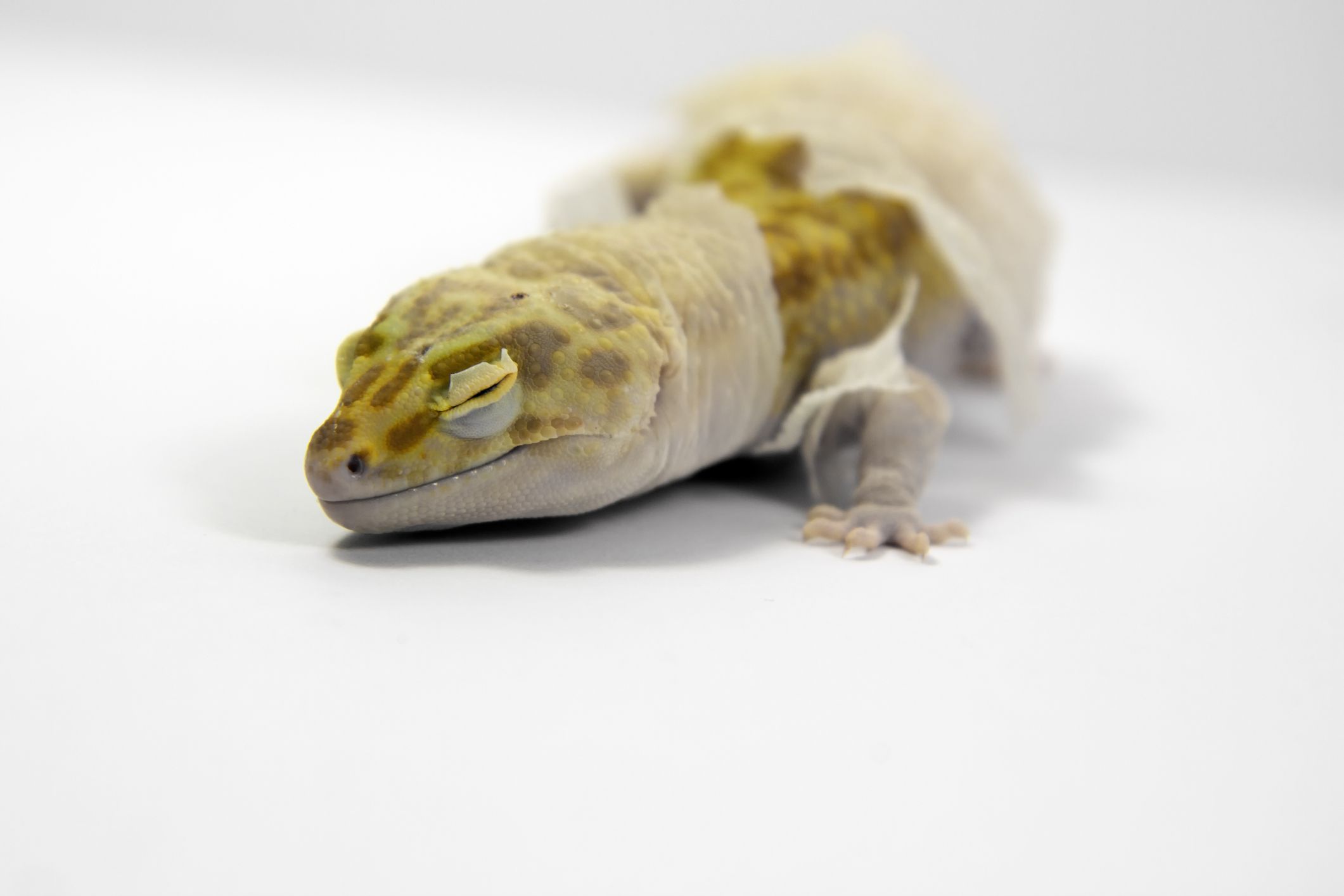All reptiles shed, and every species has its normal shedding pattern. Dysecdysis happens is when a reptile sheds abnormally, usually leading to a skin buildup on the limbs and eyelids. If dysecdysis occurs, it may indicate a problem in your reptile's environment or an underlying health issue. For example, if an enclosure is not adequately humidified or your reptile has a skin parasite, it may develop dysecdysis and require manual skin removal. Vets can diagnose dysecdysis with a physical examination and create a treatment plan accordingly. The best way to prevent the condition is by maintaining the safest, healthiest enclosure space possible for your pet.
What Is Dysecdysis?
Dysecdysis is the abnormal shedding of a reptile's skin. While the condition can refer to any abnormality, it often manifests as the skin your reptile should shed, building up in layers. When dysecdysis occurs and a reptile sheds irregularly, health problems may arise. Knowing what's normal for your pet is essential to detect any abnormality. Dysecdysis most commonly occurs in snakes.
Symptoms of Dysecdysis in Reptiles
Dysecdysis will appear as skin buildup on your reptile's body. As soon as you notice shedding abnormalities, consult your vet.
Dysecdysis may be harder to notice in some reptiles that are naturally lighter in color, like bearded dragons or leopard geckos. After your reptile sheds, a thorough inspection can help you spot the signs of skin buildup. The skin loses its sheen during shedding, so look for dull or pale shed remnants on your reptile's body. Skin buildup most commonly occurs in the armpits, feet, tail tips, eyes, and belly but can happen anywhere on your reptile. If the dead skin collects on the feet, individual toes, or the tail, blood circulation may become restricted and cause the appendages to die and fall off. Buildup on the eyes can cause difficulty seeing and eating, leading to eye infections or blindness if untreated.

Fernando Trabanco Fotografía / Getty Images
Causes of Dysecdysis
There are several reasons why a reptile may not have a complete shed.
- Enclosure issues: Most often, dysecdysis occurs due to inadequate living conditions for your reptile. This is usually due to low humidity in an enclosure and insufficient objects for your reptile to rub against while shedding.
- Skin trauma: Trauma to your reptile's skin, such as excessive or incorrect handling, may cause dysecdysis. You should never handle a reptile while it's shedding.
- Low vitamin A levels: Reptiles need vitamin A for proper skin cell growth, and a deficiency can lead to dysecdysis. Oral supplements are effective in increasing your reptile's vitamin A levels.
- Parasites: In the intestine or the skin, parasites can cause dysecdysis in reptiles. Skin mites can cause anemia or transmit diseases that may contribute to the development of dysecdysis.
- Disease and infection: If your reptile has a bacterial or viral illness or infection, dysecdysis may occur as a symptom. Septicemia, a bacterial infection of the blood, and paramyxovirus, a respiratory and neurological virus, are both known to cause the condition. Internal abscesses may also lead to dysecdysis.
Diagnosing Dysecdysis in Reptiles
To diagnose dysecdysis, your vet will perform a physical examination of your reptile, examine its medical history, and ask questions concerning its husbandry. Typically, your vet will be able to diagnose dysecdysis by looking at your reptile with their naked eye and then will move on to determining the primary cause of the condition. If the explanation isn't attributable to problems with your reptile's enclosure, your vet may perform a series of tests and search for external parasites.
Treatment
The best way to treat dysecdysis is to remove the skin following a softening, warm water soak. After about ten to thirty minutes of soaking, you should be able to peel off your reptile's buildup easily and gently. Be careful not to damage the healthy skin underneath the dead skin when removing the shed. You may use tweezers to help peel off small pieces of skin, and repeated application of ointment will help retained eye caps fall off. You should never remove eye cap buildup with tweezers.
Your vet may recommend a humidity chamber for your reptile to help moisten and loosen the skin. You can make a humidity chamber using a spacious aquarium tank containing wet bath towels, placed atop a heater and covered with a light cloth.
Prognosis for Reptiles With Dysecdysis
Dysecdysis itself is easy to treat and has a quick recovery time, but the primary condition causing the abnormal shedding may carry a more complex prognosis. If your reptile's dysecdysis results from poor tank conditions, ensuring that you make the necessary changes to its environment is essential to its recovery. If dysecdysis is not treated, it can damage your reptile's eyesight, and lead to bacterial and fungal infections.
How to Prevent Dysecdysis
The best measure you can take to prevent dysecdysis is maintaining appropriate humidity levels in your tank and ensuring your reptile has adequate surfaces to rub up against. Placing a humidity hide box in your enclosure may be helpful. Additionally, provide your reptile with a well-rounded, vet-approved diet. Preventing dysecdysis is more straightforward than treating it, so always provide your reptile with proper care.
- Is dysecdysis normal?
Dysecdysis is not typical in reptiles, but it can usually be prevented by providing adequate humidity for your pet and is easily treatable with at-home removal methods.
Can all reptiles get dysecdysis?Yes, all reptiles can develop dysecdysis, but it is most common in snakes.
Can I remove skin buildup from my reptile's eyes using tweezers?You should never use tweezers to remove the skin from your reptile's eye caps, as they can severely damage the eye. Instead, apply ointment for several days and wait for the skin to fall off.
Related Article
 Pet Information
Pet InformationHow to Prepare Your Pet for a Visit to the Groomer
IntroductionA trip to the groomer can be stressful for pets unfamiliar with grooming tools, sounds,
 Pet Information
Pet InformationThe Safest Cleaning Products to Use Around Pets
IntroductionCommon household cleaners contain chemicals that can irritate your pet’s skin, respira
 Pet Information
Pet InformationEssential Dog First Aid Tips Every Pet Owner Should Know
Essential Dog First Aid Tips Every Pet Owner Should KnowAccidents and sudden illnesses can happen to
 Pet Information
Pet InformationCaring for Dogs with Special Needs: Essential Tips
Caring for Dogs with Special Needs: Essential TipsCaring for a dog with special needs requires tailo
 Pet Information
Pet InformationHow to Care for Pet Fish: A Beginner’s Guide
IntroductionStarting an aquarium brings tranquility and beauty to your home, but improper care risks
 Pet Information
Pet InformationThe Dos and Don’ts of Pet Training: Common Mistakes to Avoid
The Dos and Don’ts of Pet Training: Common Mistakes to AvoidSuccessful pet training hinges on stra
 Pet Information
Pet InformationCaring for Exotic Pets: What You Should Know Before You Adopt
Beyond the Novelty: Responsible Exotic Pet OwnershipExotic pets – reptiles, amphibians, birds, and
 exotic-pets
exotic-petsWhat to Feed Your Pet Fox
Pet foxes eat things that are similar to what you would feed your pet dogs and cats. Foxes are omni
About Pet Universe
We are a premier digital platform committed to delivering high-quality content to our readers. Our mission is to provide accurate, reliable, and engaging information that adds value to our audience's daily lives.
Our team consists of experienced content creators and subject matter experts who uphold the highest standards of professionalism. In an era of information overload, we curate content with care, ensuring our users receive only the most relevant and trustworthy information.
Beyond just reporting facts, we focus on depth and context. Through expert analysis, comprehensive research, and clear presentation, we help our audience gain meaningful insights and make informed decisions.
We take pride in being a trusted information source for our growing community of readers. Our user-first approach means we continuously adapt to provide content that meets our audience's evolving needs and interests.
Innovation and excellence drive everything we do. We're committed to improving our platform and services to deliver the best possible experience for our users.










Comments on " Dysecdysis in Reptiles" :